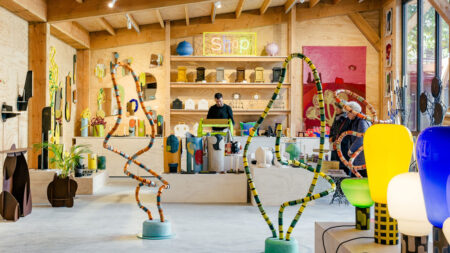The year was 1922. Four years had passed since the culmination of the war. It was a time for Italian men and women to retrospect and most importantly, rebuild their cities and restore hope in the hearts of millions of its citizens. But it was also the beginning of the fascist regime in Italy which lasted for nearly two decades.
Before World War I reached the shores of Italy, women’s primary role was to take care of homes and children. Females were involved in other works, but the number was meager. After the war, when it seemed like women finally liberated themselves from household chores and were ready to take on the world, the fascist regime came as a slap to the feminist wave.
Women were held back from performing tasks that matched the status of men and the Italian feminist movement suffered a major setback. However, there was one woman born during this age who defied all odds, completed her education, and cemented herself as one of the top names in the Italian design industry. That woman was Gabriella Crespi.

Born in the land of calves and bred in a distinguished family in Milan, Gabriella Crespi is often hailed as the diva of the design world. Over the years, she established herself in the design sphere and made a reputation of being one of the top designers, artists, manufacturers, and marketing geniuses of her time. Lauded as one of the most gorgeous ladies to have laid hands on furniture, we peek at Gabriella’s life and legacy from her daughter’s perspective.
I got in touch with Elisabetta Crespi, the daughter of the veteran designer, and tried to understand the versatility and vitality of Gabriella Crespi. “She was inspired by the universe and nature. The sun and the moon have been the great inspirers of some of her best-known collections.” Elisabetta informs.

Fascinated by the continuous and precise movement of the stars, Gabriella designed her Plurimi collection between 1970 and 1982, which included the ‘metamorphic’ tables. “She saw no barriers between interior and exterior and always wanted nature to be an integral part of any environment. Even the animal world is very present in her work as the collection of deer carved in wood or made of bronze according to the ancient processing of lost wax, or her herons that for her, represented the link between the earth and the sky,” Elisabetta continues.
Also known by the name ‘The Greta Garbo of Milan,’ Gabriella’s expertise was in sculptural furniture designs. During the 1960s and 1970s, she introduced the world to a mix of mid-century modern designs. From her lamps and coffee tables to desks, every single piece utilizes futuristic, minimalist forms of intersecting golden brass slabs, ovals, and planes.



However, what made Gabriella so great was not her designs or her flamboyant marketing image, but the time frame when she emerged into the scene. Italian industrial design was flourishing in the 20th century, courtesy of Spaghetti Western films.
The Hollywood movies of the 1950s glorified an avant-garde style of furniture design that spread across the world. And with her signature style of product and furniture design, she poured new life into the unrestrained glitz and urbane glamour of the 1970s. It was Gabriella’s moment to shine.


“Although her creations were mostly aimed at a niche audience, I believe that her talent has been recognized by most in the design world, and over time her work is increasingly known and considered,” states Elisabetta. The daughter of the famed designer also throws light on what Gabriella Crespi’s archive has in store for Milan Furniture Fair.
“Now, at the Salone del Mobile 2023, Bohemian ’72, the collection that my mother designed in 1972 and re-edited by Gubi on the occasion of her 100th Anniversary, will be exhibited during the Design Week in Milan.” She further divulges that the exhibition of her mother’s works is scheduled for 2024 and will be announced to the public when the planning will be completed.

When asked about her personal favorite in her mother’s designs, Elisabetta states, “It’s hard for me to say which of my mother’s works I love most. However, three works that I love a lot and that have always been in our house are her sculpture “My Soul” made in 1974, the “Lotus Leaves table” of 1975, and the “Kaleidoscope lamp” that she designed in 1970.”

Gabriella’s journey was not just that of grit, determination, and showing resilience in the face of adversity, it was more of an expedition in search of tranquility. “Since she was a child she sought to silence, and I always remember her drawing her creations or writing her poetry in the middle of nature, far from noisy places. The silence was another important source of inspiration for her,” Elisabetta tells me. Gabriella was so fond of quiet that she even took a vow of silence in the coming years.
Just when Gabriella was at the peak of her career, getting new projects and collaboration requests from top designers in the industry, she left her home and legacy behind and traveled to the foot of the Indian Himalayas. What looked like a brief voyage, turned out to be a 20-year self-imposed exile. “I saw her leaving with a sleeping bag and with the enthusiasm of an 18-year-old, leaving behind 30 years of work and success. At that moment, I knew that a new life would begin for her.”
From 1987 to 2007, Gabriella lived in India. “She was in charge of the decoration of the temple and I remember that this made her very happy. When my mother left for India in 1987 to meet her spiritual guide, she was 65 years old and it was a moment of her life that I always remember with great emotion.”


“I believe that spirituality is in the deepest part of each one of us and that it is not always easy to reach. Often too many distractions that life presents us every day, prevent us from remaining in contact with the spirituality that is in ourselves and that should lead us to that state of grace that nothing and no one could take away anymore. I can only agree with my mother’s choices,” Elisabetta says.
“She’s been my greatest inspiration, my major role model my whole life. With her, I learned to love beauty, to never give up in the face of obstacles, and to always go forward despite the difficulties that life presents us every day. I will continue to spread her work and protect it but above all, I will do everything possible to keep alive the memory of her life and her work,” Elisabetta concludes.
Whether it was the perils of the war Gabriella had seen or the burden of her own success, nobody truly knows what drove the accomplished designer, a wife, and a mother into spirituality. It’s been six years since the design world lost its diva. Having breathed her last in her home in Milan, Gabriella’s story won’t go down in history as that of a designer who lived by her creations, but that of a spiritual soul who maintained her vow of silence and kept it till the last breath.
Follow Homecrux on Google News!




